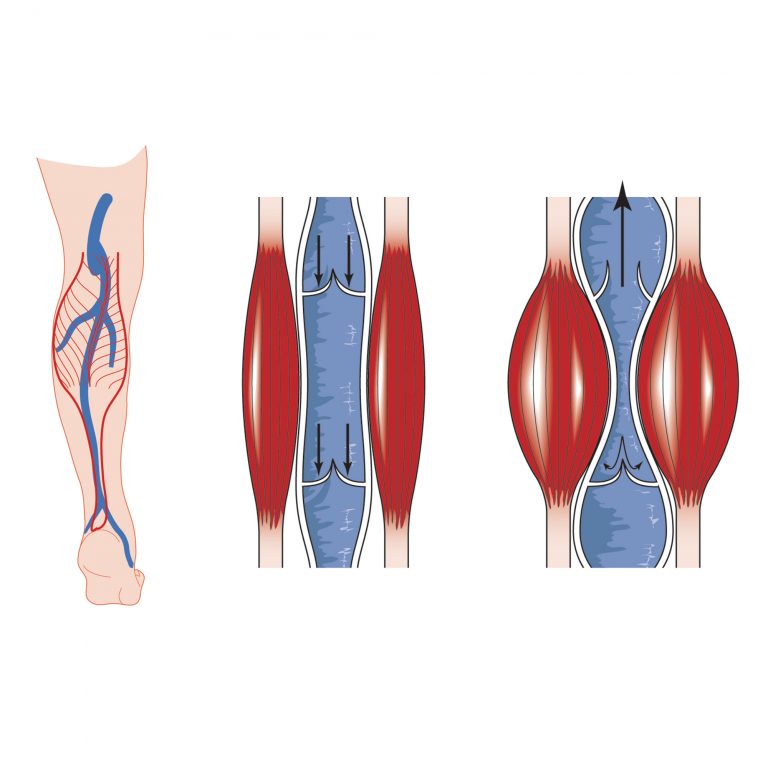The Calf Muscle Pump & Compression
The human vascular system is composed of three main parts: the arterial system, the venous system and the lymphatic system. While arteries carry oxygen to cells, veins carry deoxygenated blood back to the lungs and heart. Veins are elastic and unlike arteries, depend on one-way valves and muscle contractions to propel blood back toward the heart against the pull of gravity. Calf muscle contractions, such as when walking, are especially important in moving blood through the veins of the legs. This is called the “calf muscle pump.”
Here’s how it works:
In healthy veins, every time the calf muscle contracts, valves open and up to 70% of the blood in the legs is propelled in one direction back towards the heart. When the calf muscle relaxes, valves approximate, or tighten to close, and prevent blood from flowing backwards in the vein. This calf muscle pump, thus, ensures that the venous return back to the heart works properly. It’s crucial that in order for the calf muscle pump to function correctly, the calf muscles must be in use, such as when walking, running or exercising.
So what happens when there’s a lack of movement?
Long periods of standing or sitting can lead to high venous pressure and poor blood flow, also known as venous insufficiency. This results in damage to the veins and blood pooling in the legs. Water from the blood can then leak through vessel walls into surrounding tissues, causing swelling in the feet and legs that is common to many with poor circulation.
This is where medical compression therapy comes in. Medical Compression Stockings (MCS) are specialized hosiery designed to improve blood flow and help prevent venous disorders from occurring. MCS work in tandem with the calf muscle pump to improve circulation. This can limit more serious symptoms like skin discoloration, pain, infections and clots, and complications like Chronic Venous Disease (CVD) or Deep Vein Thrombosis (DVT). Wearing MCS in combination with frequent movement, such as walking, hiking, climbing stairs, cycling and swimming, is an important step to ensuring the efficiency of the calf muscle pump and preventing venous disease.
Who can benefit from medical compression?
Contrary to popular belief, medical compression is not just for the elderly or those with pre-existing conditions. A wide variety of individuals can benefit from compression therapy, including pregnant women, frequent travelers, office workers, those who work on their feet all day, and anyone who lives a more sedentary lifestyle.
Some common medical conditions that may benefit from compression therapy include people who suffer from a clotting disorder, have a family history of DVT, have varicose/spider veins, lymphedema, lipedema, leg ulcers and more. Also, if you’ve had a recent surgery or have been on bed rest, compression therapy can help reduce swelling and risk of clots.
Even healthy individuals can benefit from compression! Both amateur and professional athletes can experience increased blood flow, boosted performance and a speedier recovery time with less muscle soreness through compression therapy both during and immediately after exercise. Furthermore, these positive effects can continue up to 72 hours post-workout.
Office workers, healthcare workers and other individuals who either stand or sit most of the day at work can also greatly benefit from compression. Prolonged sitting is a significant risk factor for CVD and blood clots. In fact, one of the most commonly identified risk factors for blood clots is seated immobility at work. Symptoms of CVD such as pain, swelling, leg fatigue, spider and varicose veins are also known to develop due to sitting/standing professions. In fact, it is reported that nearly 70% of healthcare workers are affected by one or more symptoms of CVD.
Is there anyone who shouldn’t use compression?
In short, yes. Medical compression is not for everyone and can actually have adverse effects when used incorrectly or too much. If you have a fragile skin condition, open sores, severe peripheral neuropathy, peripheral arterial disease or any significant disease that can impede blood flow, it is usually not advised to engage in compression therapy. We always advise consulting with your medical professional if you have any questions about compression therapy.
So I think I want to try compression – where do I start?
Always consult with your doctor first but if you feel you may benefit from compression therapy, VENOSAN® offers comfortable garments in a variety of styles and colors to fit every person’s lifestyle. And for a more better fit, we manufacture garments using double covered technology.
A double covered design prevents bare elastic from touching the skin, increasing comfortability and durability. Each elastic inlay yarn is wrapped twice with fine yarns to cover it, allowing the product to glide on and off more efficiently. Depending on the product you choose, certain types of yarns can provide additional tailored benefits like odor control, moisture and bacterial growth prevention, hypoallergenic properties and a soft to the touch feel.
The support you need, with the style you want.
Ready for give VENOSAN stocking a try? Hop on over to our product catalogue to learn more about our offerings.




